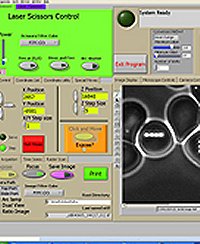Sperm wriggling in a petri dish in the US have been manipulated using internet and laser technology by scientists in Australia.
Norman Heckenberg and the University of Queensland are working on micromanipulation using a technology called RoboLase: optical tweezers, focused laser beams brighter than light on the surface of the Sun. The tweezers “trap” the sperm but the light doesn’t heat them up enough to cause damage.

In the latest experiment, Australian scientists used a control panel on their computer screen to see what the US team was looking at under the microscope. The Australians then moved the cursor over the sperm they wanted to trap, then clicked on the mouse to turn on the trapping laser beam.
The experiment showed that a bandwidth of one gigabyte per second was needed to observe and grab the slippery sperm.
The sperm experiment has implications for in vitro fertilisation, as it helps to cut the tails off the sperm because it makes them easier to handle; they can’t swim away. “Then it’s a matter of drilling a hole in the side of the ova and you pop the sperm in,” added Heckenberg.
The research shows that the internet will become increasingly useful not only for collaborative scientific research but for performing some medical procedures.
Via ABC News and News Medical.







